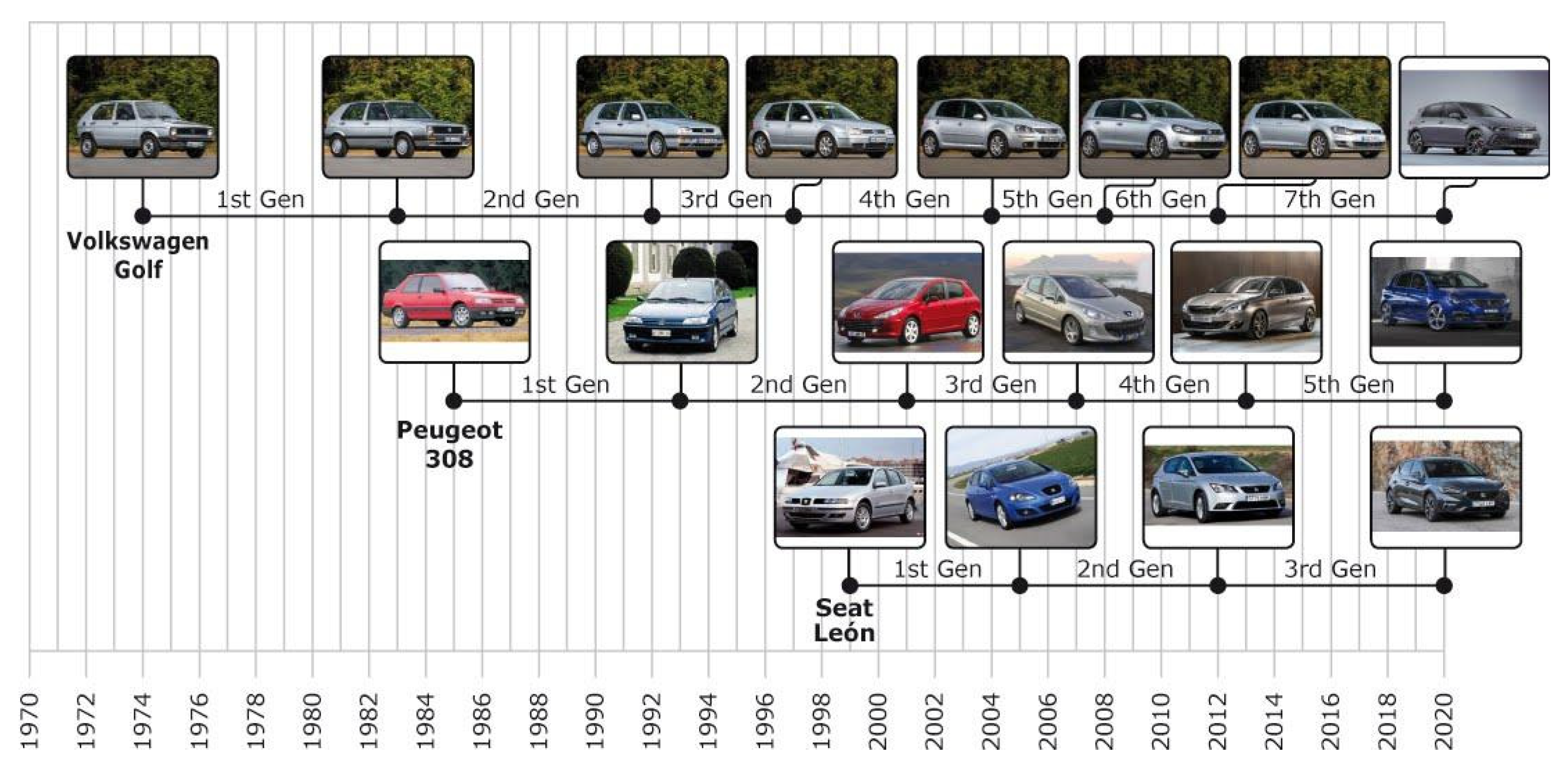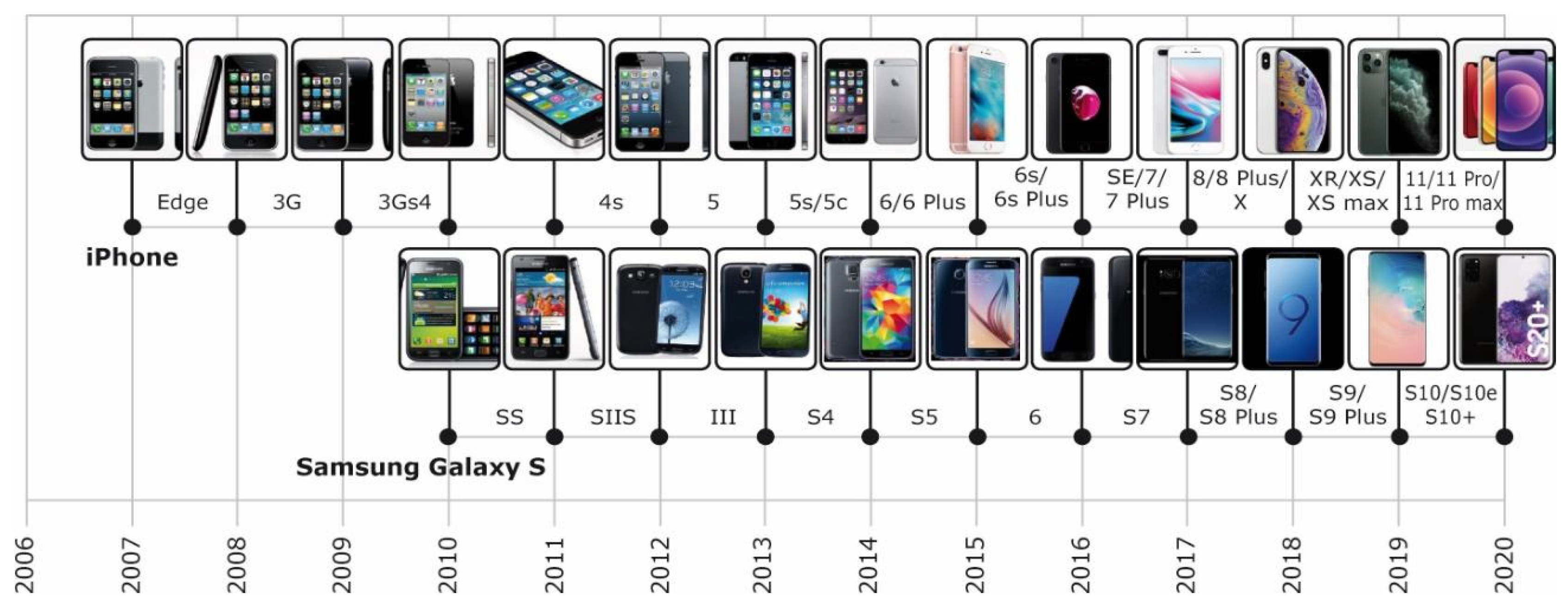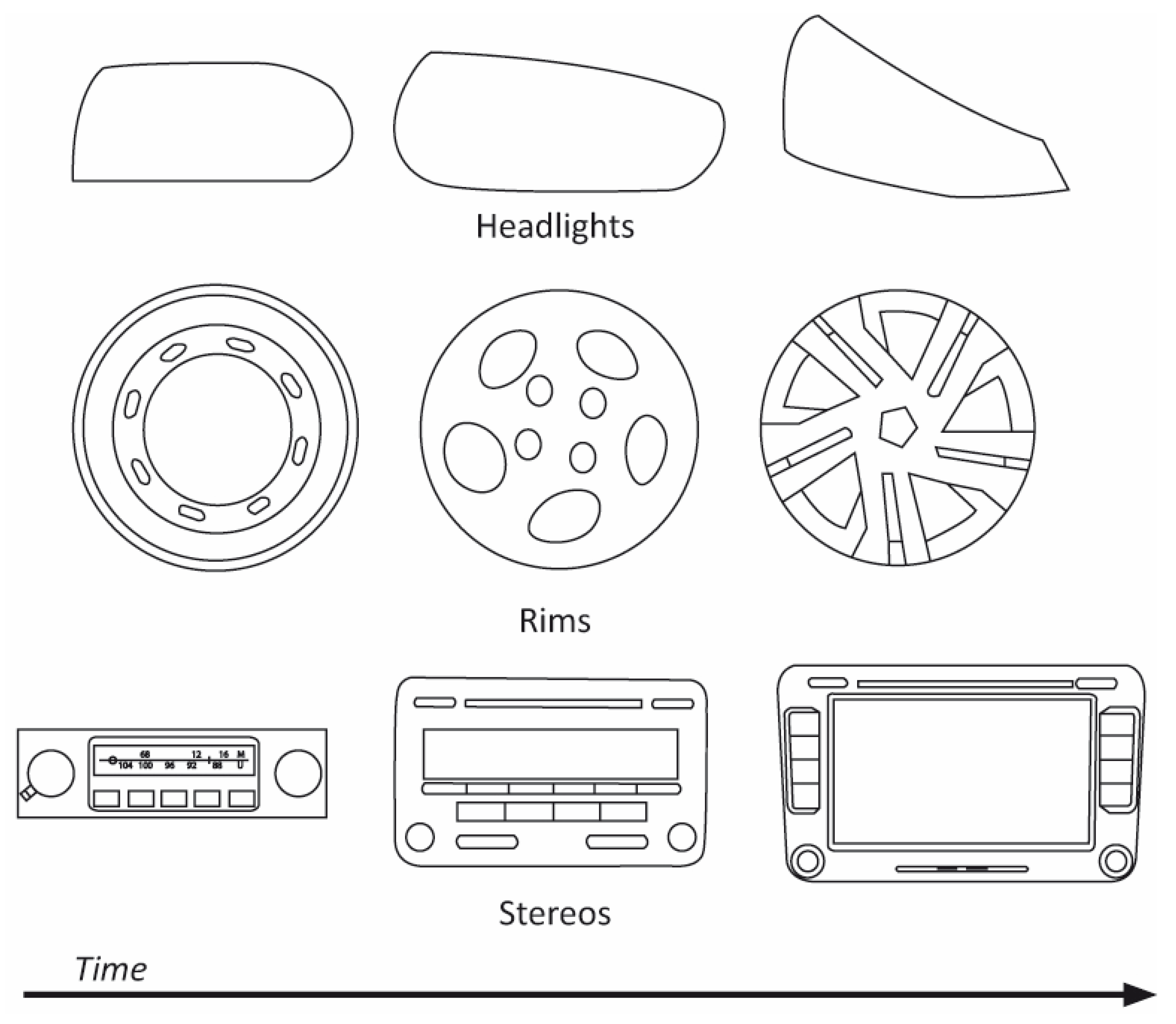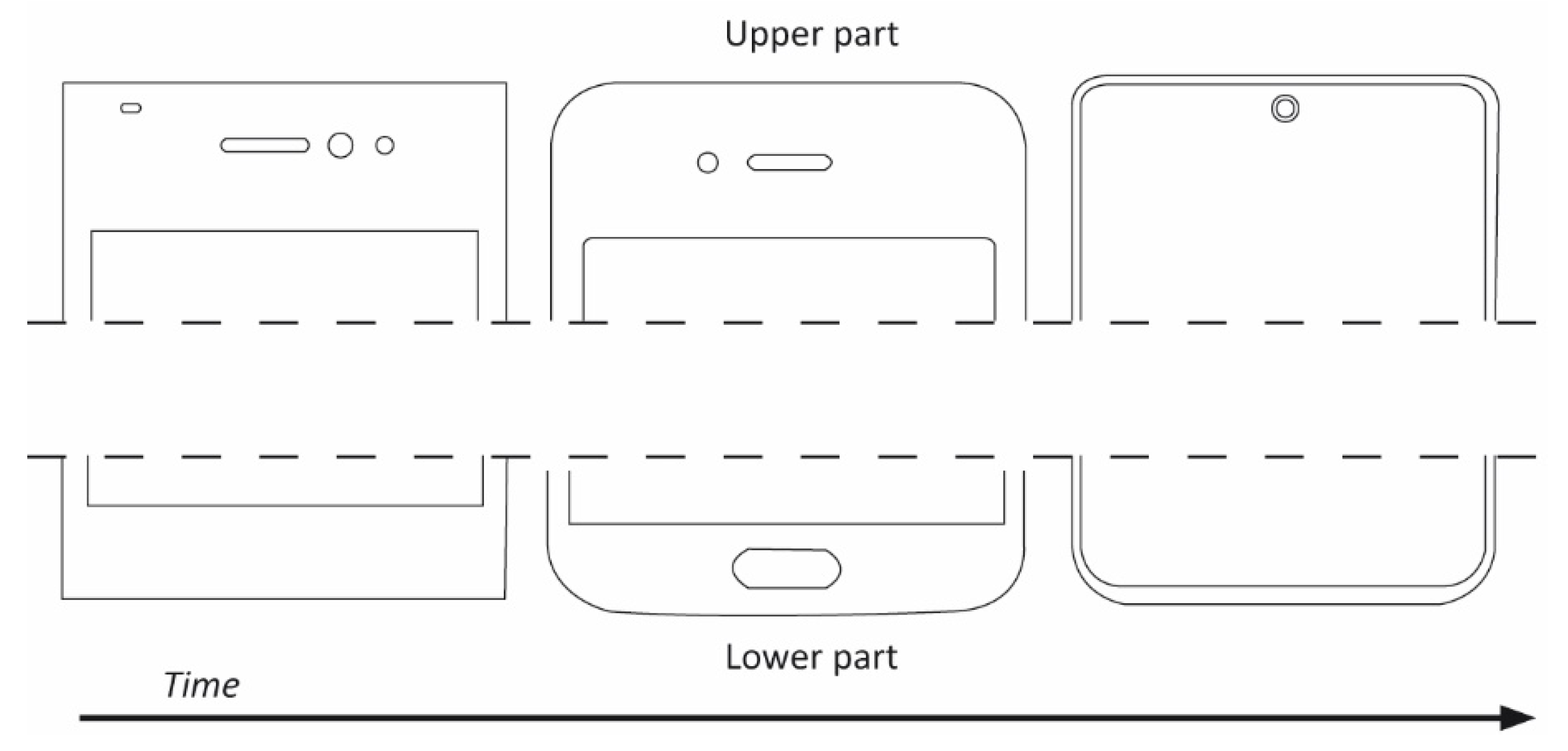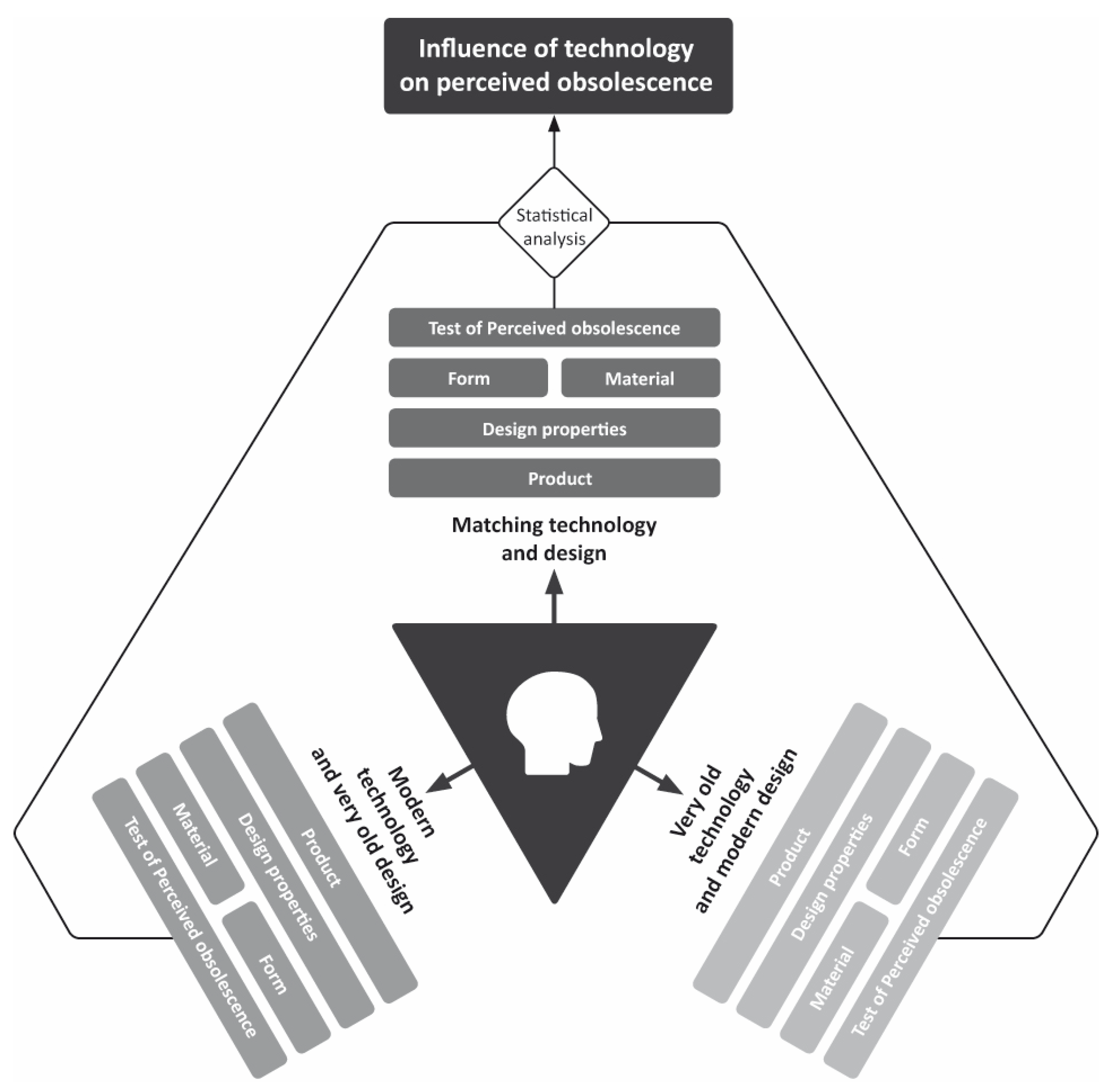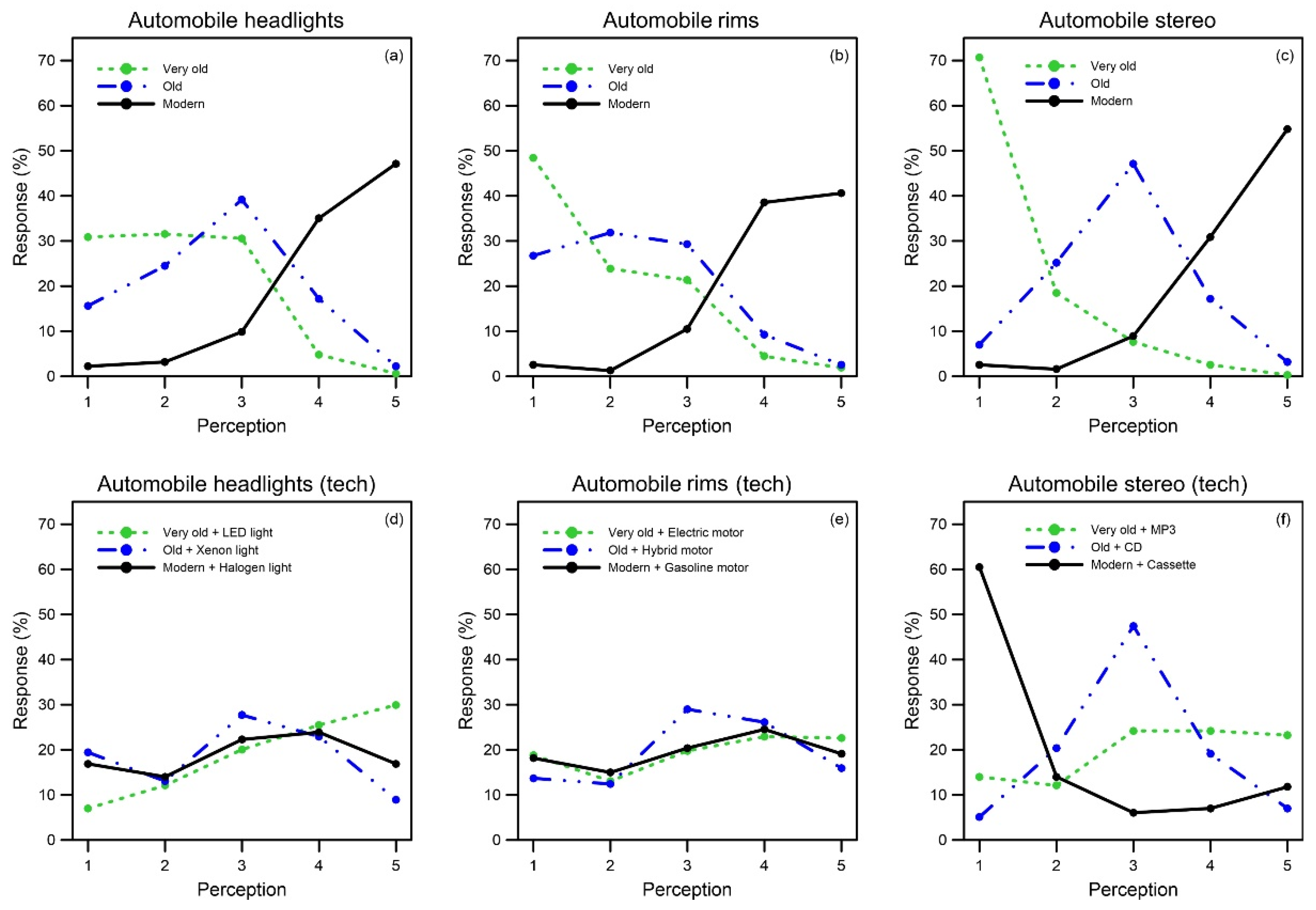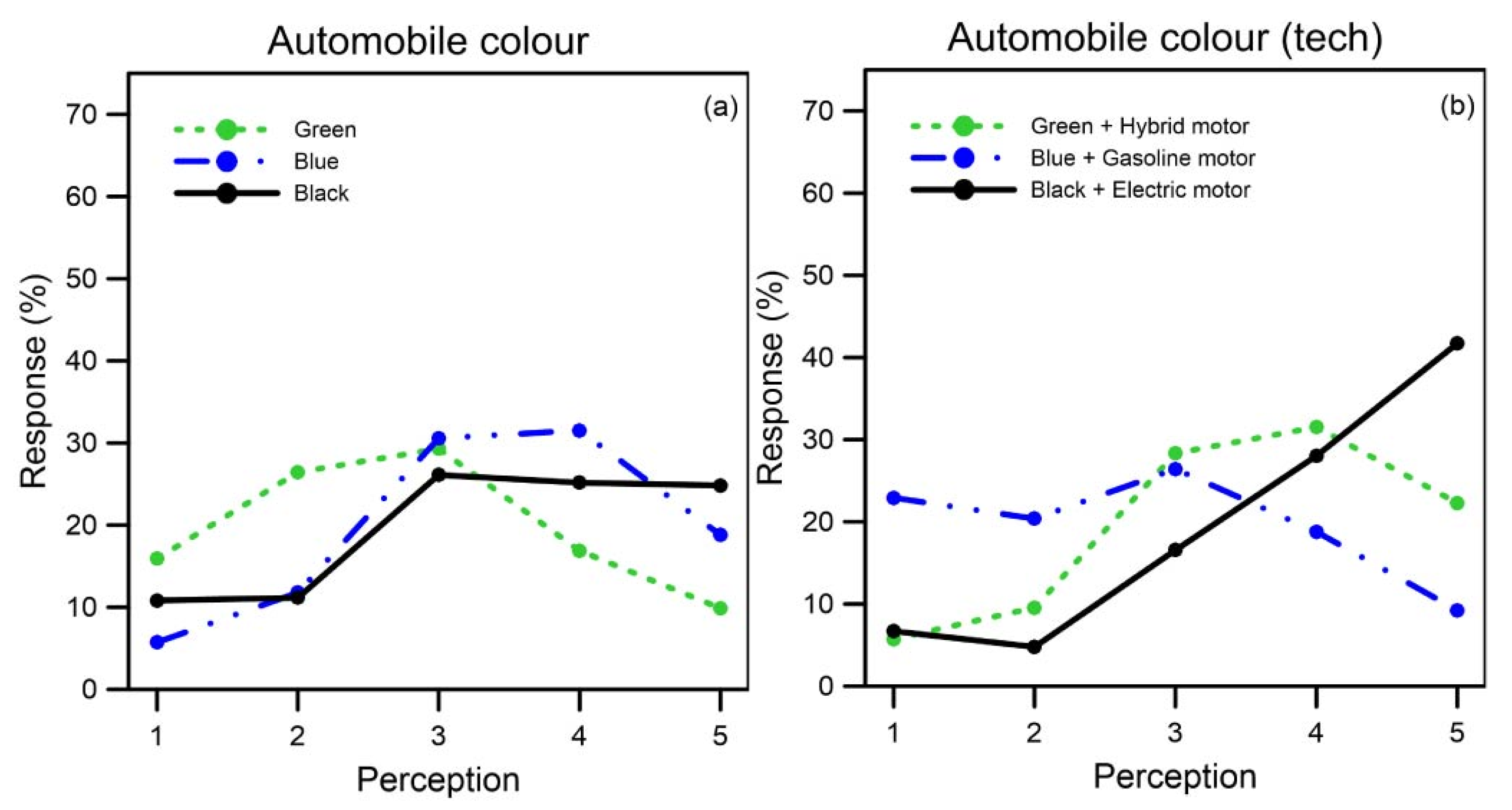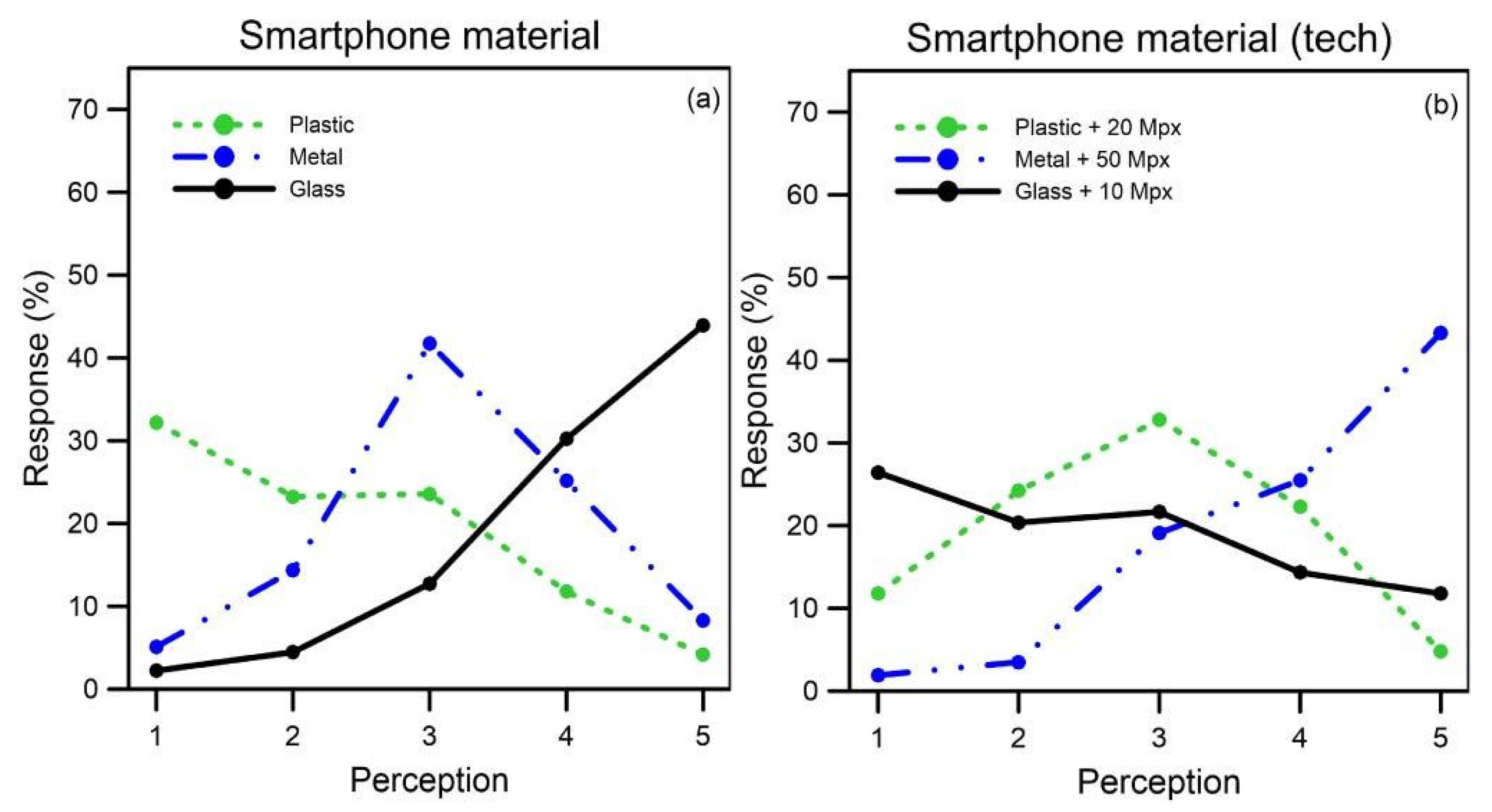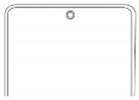4.1. Design Property: Shape
Figure 6 shows the results of the respondents’ ratings of their perceived obsolescence of the shapes of different vehicle parts: (a) headlights; (b) rims; and (c) the stereo. In all three cases the trend line for very old products (dotted line) decreases as a function of perceived obsolescence. The percentage of users who rated these shapes as obsolete (values 1 and 2 on the Likert scale) was 62.4% in the case of headlights, 72.3% in the case of tyres and 89.2% in the case of the stereo. Therefore, users rated products as obsolete that had actually been on the market for several years.
On the other hand, users rated modern shapes (solid line) as current (values 4 and 5 on the Likert scale) with 83.0% for headlights, 83.1% for wheels, and 85.7% for stereos. The line representing the old shape (double dot-dash line) indicates that users tend to rate such shapes in the middle zone of the Likert scale (value 3 on the Likert scale). Their percentages were: 39.2% headlights, 29.3% wheels and 47.1% stereos.
As can be seen, respondents perceive the semantics of the product in a similar way to the chronology outlined in the section on design evolution, with the most modern products being perceived as current in a more obvious way. This indicates that when several images are shown for comparison, it is easier for the user to discern the more modern forms and assess them as current. In the case of the stereo, there was a consensus that this product was very old, perhaps due to the fact that it is a multimedia product and lacks a screen. The design this part of the vehicle forces the user to interact with it in different ways, and therefore, it requires greater attention. Thus, regardless of whether a particular user is more or less sensitive to design changes, having to interact with the product in different ways (by hand, touch or voice) makes formal and technological changes more apparent, and therefore the older product was easily identified as obsolete.
Subsequently, respondents were asked for their assessment of the degree of obsolescence of the aforementioned forms by assigning them a technological attribute. The technological attributes were associated in an anachronistic way. Modern headlight shapes were assigned an obsolete halogen light technology, while very old shapes were assigned modern technology, in this case LED lights; old headlights were associated with xenon light as it is a chronologically intermediate technology. Similarly, in the case of the wheel rims, the most modern forms were assigned an old petrol engine, the very old forms were assigned an electric motor, while the old forms were assigned a hybrid engine. Likewise, in the case of the stereos, modern forms were assigned obsolete cassette technology, very old forms were assigned MP3 technology, and old forms were assigned intermediate CD technology.
By comparing the initial responses with these assessments, it was possible to measure the influence of technology on the perception of formal obsolescence.
According to the results, the responses changed significantly with the inclusion of the technological attribute (see
Figure 6). Two behavioural patterns were distinguished. In
Figure 6d,e, the three lines are overlapping and flat, indicating that there is no consensus among users and that from a semantic point of view, they interpret in an undefined way what was previously interpreted as clearly obsolete or current. This not only indicates the users perception, but also the clarity with which users interpret the forms. It should be noted that these two graphs refer to the headlights and wheels, while in
Figure 6c,f, the stereo, which is a multimedia device, is analysed. In this case, user responses also changed significantly. However, the responses were diametrically opposed. Users who perceived stereo forms as obsolete, valued them as modern by including a current technological attribute. Similarly, very modern stereos were perceived as obsolete because they were associated with obsolete technologies. On the other hand, intermediate stereos were still interpreted in a similar way, having been assigned an intermediate attribute.
In order to assess whether the technological variable had a significant influence on the perception of obsolescence, the chi-square statistical test was used, which provides information on the dependence or independence at a given level of significance. In this work, a minimum significance level of
p < 0.01 was used, i.e., if there was dependence between the variables studied, the level of certainty had to have at least 99% confidence. For this purpose, the corresponding contingency tables were calculated for the oldest and most modern vehicle shapes for the headlamps, wheels and stereo.
Table 1 shows the chi-square values for each of the vehicle shape attributes.
For four degrees of freedom and a significance level of 99%, the cut-off value for the Chi-square statistic was 13.27. Thus, statistical values lower than the above cut-off value imply the acceptance of the null hypothesis, i.e., they indicate that the variables analysed are independent and that the values obtained are due to a random distribution. However, if the values obtained are higher than this limit, the alternative hypothesis is accepted, which leads to the conclusion that there is dependence between the variables analysed. Given that the Chi-square values are much higher than the threshold value (
Table 1), it can be concluded that there is a relationship between the perception of obsolescence and the technological variable; therefore, when a technological factor is incorporated into different parts of the vehicle, users’ responses change significantly, modifying their perception of obsolescence.
Based on the analysis of the above information, two models of user perception can be recognised: on the one hand, behaviour linked to products in which minimal actions are required by the user to make them work (headlights and tyres), and on the other hand, products in which interaction with the user is fundamental to their operation (stereo). Indeed, in recent years, the automotive industry has relied on the use of multimedia elements as a way to update its models, such as voice control, music streaming, GPS navigation, among others.
Figure 7 shows the results of the respondents’ ratings of their perception of obsolescence regarding the shapes of the different parts of the smartphone: (a) upper front; (b) and lower front.
The trend lines for the modern upper and lower front (solid line) are similar, and were rated mainly with scores between 4 and 5 on the Likert scale, with 80.9% for the upper front and 83.1% for the lower front. The old components had percentages of 24.8% and 31.5%, respectively, while the very old component was evaluated with scores of 59.2% and 55.7%. As can be seen, respondents perceive obsolescence in a similar way to the chronology presented in the case study. As in the case of the vehicle, modern components were clearly perceived as current. For the older components, the curves are bell-shaped, with maximum scores at values of 2–3 on the Likert scale, and for the very old components, the curves are decreasing with maximum scores at values of 1–2 on the Likert scale (see
Figure 7a,b). The similarity between the two graphs may be due to the fact that the user is evaluating a multimedia product that requires direct interaction for its operation, as in the case with stereos.
The fact that the user is clear about the evaluation of this product can be explained by the prominence of screens in audiovisual technologies, since their historical development has progressed from more balanced formats, such as a ratio of 4:3, to more panoramic ones such as 16:9. This evolution of the screen ratio, as well as the increase in the size of the screen, has occurred in many devices in which screens play a leading role, such as televisions, computer monitors and tablets.
Next, users were again asked about the degree of perceived obsolescence of the product shapes. However, on this occasion, these shapes were linked to a technological attribute. The differences between the responses obtained enabled us to assess the influence of the technological factor. In the same way as for vehicles, the technological factor was anachronistically linked to images of smartphone parts. For the upper front: 5G was linked to very old components, 4G to intermediate ones and GSM to modern ones; for the lower front: face lock was linked to very old components, fingerprint unlock was kinked to intermediate ones and a security pattern was linked to modern smartphones.
These results are shown in
Figure 7c,d. The percentages for the modern case range between 37.6% for the upper front and 24.8% for the lower front (values 4 and 5 on the Likert scale). In the intermediate (old) case, the values range between 34.1% and 31.5%, respectively (values 3 on the Likert scale); and in the very old case they range between 15.3% and 17.5%, respectively (values between 1 and 2). In the case of the modern components, it can be observed that the responses have changed and there is no consensus among the respondents, resulting in a flatter graph. In the intermediate case, the bell curve has shifted to the right, indicating that it is perceived to be slightly more current with this technological assignment. In a similar way, the graph shows a clearer response from users in the case of very old components and with regard to both the upper front and the lower front, when the component was assigned a state-of-the-art technological attribute.
For four degrees of freedom and a significance level of 99%, the cut-off value for the Chi-square statistic is 13.27. Thus, statistical values lower than the above threshold value lead to the acceptance of the null hypothesis, i.e., they indicate that the variables analysed are independent and that the values obtained are due to a random distribution. However, if the values obtained are higher than this limit, the alternative hypothesis is accepted, which leads to the conclusion that there is dependence between the variables analysed. Given that the Chi-square values are much higher than the threshold value (
Table 2), it can be concluded that there is a relationship between the perception of obsolescence and the technological variable, so that when a technological factor is incorporated into different parts of the smartphone, users’ responses change significantly, modifying their perception of obsolescence.
These results indicated that the smartphone, being a multimedia product, is very sensitive to changes in technology. In the case of very old components with state-of-the-art technology, users attributed more importance to the technological factor, which is similar to the car stereo. With regard to the intermediate (old) component, the technological factor also improved the users’ perception of topicality, but not as much as in the previous case, as less cutting-edge technologies were used. The linking of obsolete technologies, such as GSM or an unlocking pattern to modern shapes reduces the degree of perceived obsolescence; they go from being shapes valued as very current to a situation of little consensus, as can be deduced from the flattened lines or lines with a slight negative slope (
Figure 6a,b). The reason for this lack of consensus may be due to several factors. In the case of GSM, it may be due to a certain lack of user awareness of the technology. It is worth noting that the percentage of users who replied NS/NC to the GSM question was 13.4%, which was higher than the other questions. Unlocking patterns are technologies that currently coexist with other more cutting-edge technologies. In any case, the effect of assigning an obsolete technological factor also significantly modifies the perception of the obsolescence of the product with modern forms, which confirms that the technological factor has a modulating effect on the perception of formal obsolescence; this is of greater significance in the case of multimedia devices.
4.2. Design Property: Colour and Material
The colours green, blue and black were analysed by applying them to the bodywork of automobiles. Unlike the previous sections, the colours did not follow a chronological order, so the interest lies in discovering whether there is a link between a timeless design property and perceived obsolescence when including a technological component.
Figure 8 demonstrates that none of the three colours show an obvious trend related to the respondent’s perception. In general, most of the scores for the three colours fall between the intermediate values of 2, 3 and 4. This indicates that users were not clear about the degree of obsolescence of these three colours. Despite this, there are slight differences in the trends of the lines, which allowed us to establish that green is considered slightly more obsolete, while blue and black are considered more current.
When the technological factor is introduced, it is observed that the green colour changes from being slightly flared to the left to being slightly flared to the right. This is due to the fact that it is associated with a hybrid engine, which is perceived as more modern. In the case of the blue colour, the behaviour is the opposite of the previous one, although with slight shifts from the right to the left of the graph. This is due to the fact that a petrol engine was selected and was interpreted as more obsolete. Finally, the black colour shows a clear tendency to be valued as very modern, as it is associated with an electric motor.
This suggests that the influence of technology on colour is considerably less than on the shape property. Therefore, major technological changes with respect to colour lead to moderate changes in the perception of users.
For four degrees of freedom and a significance level of 99%, the cut-off value for the Chi-square statistic is 13.27. Thus, statistical values lower than the above cut-off value imply the acceptance of the null hypothesis, i.e., they indicate that the variables analysed are independent and that the values obtained are due to a random distribution. However, if the values obtained are higher than this limit, the alternative hypothesis is accepted, which leads to the conclusion that there is dependence between the variables analysed. Given that the Chi-square values are higher than the threshold value (
Table 3), it can be concluded that there is a relationship between the perception of obsolescence and the technological variable, so that when a technological factor is incorporated into the vehicle colours, the users’ responses change significantly, modifying their perception of obsolescence.
For the study of the material in smartphones, the casing was used as a perceptible design property due to the importance it plays in their appearance. The following materials were used: plastic, metal and glass.
Figure 9 shows a clear differentiation between the perception rating of the three materials. Plastic shows a clear downward trend with a percentage of 55.4% in Likert scale scores 1 and 2, which indicates that it is perceived as an obsolete material. In the middle position is metal, with a bell-shaped graph and with a score of 3 being chosen by 41.7% of the respondents. Finally, glass is considered to be a current material, since the graph is ascending and 74.2% of the respondents chose values of 4 and 5 on the Likert scale. This assessment also coincides with the chronology of the historical application of these materials in smartphones.
When the technological aspect is introduced, the situation changes considerably, with plastic, together with a 20 Mpx camera, being rated with a percentage of 36.0% for values between 1 and 2 on the Likert scale, with a flared shape in the middle of the graph. In the case of metal, the percentage is 19.1%, stopping at the value of 3 on the graph. Therefore, there is a change from a bell-shaped line to a clearly ascending one with very high ratings at point 5. This is due to the fact that it was linked to the latest technology, in this case, a 50 Mpx camera, and last but not least, the rating for glass material change diametrically. When the technological factor is added, the respondents rate it with 26.1% at values of 4 and 5.
For four degrees of freedom and a significance level of 99%, the cut-off value for the Chi-square statistic is 13.27. Thus, statistical values lower than the above cut-off value imply the acceptance of the null hypothesis, i.e., they indicate that the variables analysed are independent and that the values obtained are due to a random distribution. However, if the values obtained are higher than this limit, the alternative hypothesis is accepted, which leads to the conclusion that there is dependence between the variables analysed. Given that the Chi-square values are higher than the threshold value (
Table 4), it can be concluded that there is a relationship between the perception of obsolescence and the technological variable, so that when a technological factor is incorporated into the material of the smartphones, the users’ responses change significantly, modifying their perception of obsolescence.
